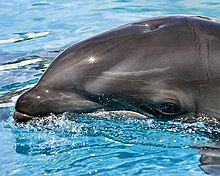Bottlenose dolphin
Bottlenose dolphins are aquatic mammals in the genus Tursiops. They are common, cosmopolitan members of the family Delphinidae, the family of oceanic dolphins.[2] Molecular studies show the genus definitively contains two species: the common bottlenose dolphin (Tursiops truncatus) and the Indo-Pacific bottlenose dolphin (Tursiops aduncus).[3] Others, like the Burrunan dolphin (Tursiops (aduncus) australis), may be alternately considered their own species or be subspecies of T. aduncus.[4] Bottlenose dolphins inhabit warm and temperate seas worldwide, being found everywhere except for the Arctic and Antarctic Circle regions. Their name derives from the Latin tursio (dolphin) and truncatus for their characteristic truncated teeth.[5]
Numerous investigations of bottlenose dolphin intelligence have been conducted, examining mimicry, use of artificial language, object categorization, and self-recognition. They can use tools (sponging; using marine sponges to forage for food sources they normally could not access)[6] and transmit cultural knowledge from generation to generation, and their considerable intelligence has driven interaction with humans. Bottlenose dolphins gained popularity from aquarium shows and television programs such as Flipper. They have also been trained by militaries to locate sea mines or detect and mark enemy divers. In some areas, they cooperate with local fishermen by driving fish into their nets and eating the fish that escape. Some encounters with humans are harmful to the dolphins: People hunt them for food, and dolphins are killed inadvertently as a bycatch of tuna fishing and by getting caught in crab traps.
Bottlenose dolphins have the third largest encephalization levels of any mammal on Earth (humans have the largest), sharing close ratios with those of humans and other great apes, which more than likely contributes to their high intelligence and emotional intelligence.[7]
Scientists have been long aware of the fact that the Tursiops dolphins might consist of more than one species, as there is extensive variation in color and morphology along its range. In the past, most studies used morphology to evaluate differences between and within species, but in the late 20th century, combining morphological and molecular genetics allowed much greater insight into this previously intractable problem.[8] Since the late 1990s and early 2000s, most researchers acknowledged the existence of two species:[9] the common bottlenose dolphin (T. truncatus), found in coastal and oceanic habitats of most tropical to temperate oceans, and the Indo-Pacific bottlenose dolphin (T. aduncus), that lives in coastal waters around India, northern Australia, South China, the Red Sea, and the eastern coast of Africa.



